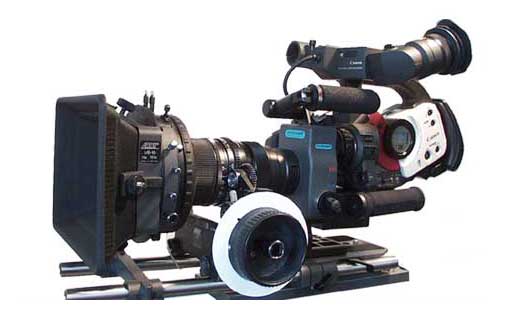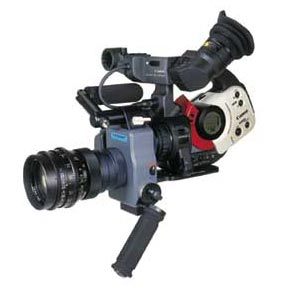 Film
Look Adaptor Film
Look Adaptor
DV camcorders, where the tiny chip sizes mean the problem is worst, can
now use 35mm film lenses and obtain exactly the same focal length and
depth of field as a 35mm camera, thanks to the new Mini35
Digital adapter from P+S Technik. This already works with the popular
Sony PD-150/VX-2000 and Canon XL1 models. Versions for Digital Betacam
and HDCAM cameras are also in development.
Film lenses are designed to project a 35mm image, which is huge compared
to the size of a video CCD (some seven times than of the one-third inch
chips used on the XL1 and PD-150). "If you project it directly on
to the CCD, you only use a small fraction of the middle of the 35mm image.
You change the angle of the lens. A standard lens becomes a telephoto
lens, so you never get the 35mm feeling. With this it stays exactly the
same," explains freelance cameraman, Ben Gabel.
"This is a problem with even HD, because it never has the same
depth of field as 35mm has, because this is connected to the physical
size of the image," he says.
However, the Mini35 Digital gives excellent depth of field. "We
do it by projecting the image on to a little screen, exactly the same
size as the 35mm negative. Then we lead it through a block of prisms and
a second lens on to the CCD," he explains. Although it is simple,
no one has done it before.
There are, however, some optical problems. The 35mm screen is made of
ground glass, which would add grain to the image, except that P+S Technik
rotates the screen at about 800 revolutions per minute, so that it becomes
a "very smooth vertical surface," he says.
"It is one of the pains of videography that you want to make it
look like film so much. I, as a cameraman, helped to start the project
because I couldn't stand the video look any more," he says.
 It
is not necessary to use expensive cinematic prime lenses, as the system
can also use photo mount lenses such as Canon or Nikon as well as Panavision
or other film lenses. The adapter also has two adjustable handgrips to
facilitate hand-held use. It
is not necessary to use expensive cinematic prime lenses, as the system
can also use photo mount lenses such as Canon or Nikon as well as Panavision
or other film lenses. The adapter also has two adjustable handgrips to
facilitate hand-held use.
He believes DV can produce a more film-like image than HD, because "it
gives a softer, warmer look than the sharpness of HD."
The XL1 unit (which costs 7,670 Euros) is already available through
four rental houses in Germany and some in the US. It is currently hand-built
at about ten per month, but P+S Technik hopes to move to mass production
by the end of the year, with the 7,160 Euro PD-150 version entering production
at the end of October. They hope to have a version for two-third inch
CCD cameras by mid-2002.
back to the top
|

